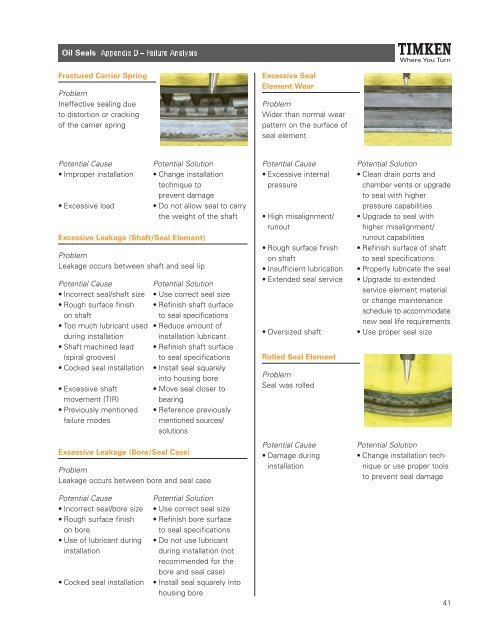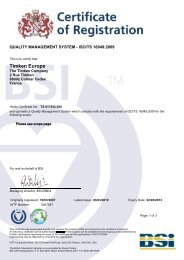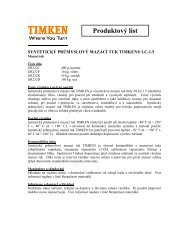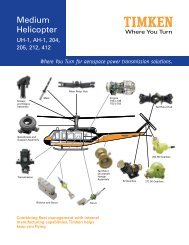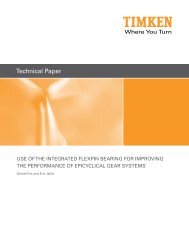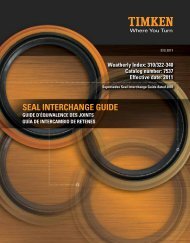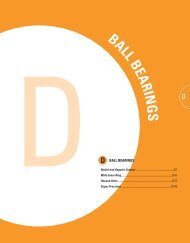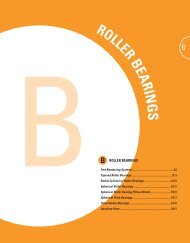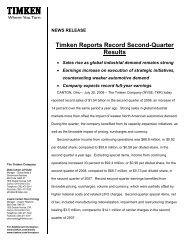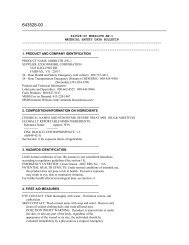- Page 1: Timken Industrial Seal Catalog High
- Page 4 and 5: Introduction At Timken, customers t
- Page 7 and 8: Technology Overview Turn to Timken
- Page 9 and 10: Engineering Data Comparing Shaft Le
- Page 11 and 12: Engineering Data Table 7: Shaft and
- Page 13 and 14: Seals Installation Instructions Ins
- Page 15 and 16: Seal & Material Selection Seal Sele
- Page 17 and 18: Oil Seals Product Information Large
- Page 19 and 20: Oil Seals Product Information Large
- Page 21 and 22: Oil Seals Product Information Shaft
- Page 23 and 24: Oil Seals Product Information Speci
- Page 25 and 26: Bearing Isolators Configurations Bo
- Page 27 and 28: Bearing Isolators Product Informati
- Page 29 and 30: Glossary Width Assembled Seal made
- Page 31 and 32: Oil Seals Appendix A - Product Iden
- Page 33 and 34: Oil Seals Appendix A - Product Iden
- Page 35 and 36: Oil Seals Appendix A - Product Iden
- Page 37 and 38: Oil Seals Appendix B - Obsolete App
- Page 39 and 40: Oil Seals Appendix C - Compound Com
- Page 41 and 42: Oil Seals Appendix C - Compound Com
- Page 43 and 44: Oil Seals Appendix C - Compound Com
- Page 45: Oil Seals Appendix D - Failure Anal
- Page 49: Relationship Between RPM, FPM and S
- Page 52 and 53: M-2
- Page 54 and 55: Oil Seals by Model Number Model Num
- Page 56 and 57: Product Inches MM Model Code ID OD
- Page 58 and 59: Product Inches MM Model Code ID OD
- Page 60 and 61: Product Inches MM Model Code ID OD
- Page 62 and 63: Product Inches MM Model Code ID OD
- Page 64 and 65: Product Inches MM Model Code ID OD
- Page 66 and 67: Product Inches MM Model Code ID OD
- Page 68 and 69: Product Inches MM Model Code ID OD
- Page 70 and 71: Product Inches MM Model Code ID OD
- Page 72 and 73: Product Inches MM Model Code ID OD
- Page 74 and 75: Product Inches MM Model Code ID OD
- Page 76 and 77: Product Inches MM Model Code ID OD
- Page 78 and 79: Product Inches MM Model Code ID OD
- Page 80 and 81: Product Inches MM Model Code ID OD
- Page 82 and 83: Product Inches MM Model Code ID OD
- Page 84 and 85: Product Inches MM Model Code ID OD
- Page 86 and 87: Product Inches MM Model Code ID OD
- Page 88 and 89: Product Inches MM Model Code ID OD
- Page 90 and 91: Product Inches MM Model Code ID OD
- Page 92 and 93: Product Inches MM Model Code ID OD
- Page 94 and 95: Product Inches MM Model Code ID OD
- Page 96 and 97:
Product Inches MM Model Code ID OD
- Page 98 and 99:
Product Inches MM Model Code ID OD
- Page 100 and 101:
Product Inches MM Model Code ID OD
- Page 102 and 103:
Product Inches MM Model Code ID OD
- Page 104 and 105:
Product Inches MM Model Code ID OD
- Page 106 and 107:
Product Inches MM Model Code ID OD
- Page 108 and 109:
Product Inches MM Model Code ID OD
- Page 110 and 111:
Product Inches MM Model Code ID OD
- Page 112 and 113:
Product Inches MM Model Code ID OD
- Page 114 and 115:
Product Inches MM Model Code ID OD
- Page 116 and 117:
Product Inches MM Model Code ID OD
- Page 118 and 119:
Product Inches MM Model Code ID OD
- Page 120 and 121:
Product Inches MM Model Code ID OD
- Page 122 and 123:
Product Inches MM Model Code ID OD
- Page 124 and 125:
Product Inches MM Model Code ID OD
- Page 126 and 127:
Product Inches MM Model Code ID OD
- Page 128 and 129:
Product Inches MM Model Code ID OD
- Page 130 and 131:
Product Inches MM Model Code ID OD
- Page 132 and 133:
Product Inches MM Model Code ID OD
- Page 134 and 135:
Product Inches MM Model Code ID OD
- Page 136 and 137:
Product Inches MM Model Code ID OD
- Page 138 and 139:
Product Inches MM Model Code ID OD
- Page 140 and 141:
Product Inches MM Model Code ID OD
- Page 142 and 143:
Product Inches MM Model Code ID OD
- Page 144 and 145:
Product Inches MM Model Code ID OD
- Page 146 and 147:
Product Inches MM Model Code ID OD
- Page 148 and 149:
Product Inches MM Model Code ID OD
- Page 150 and 151:
Product Inches MM Model Code ID OD
- Page 152 and 153:
Product Inches MM Model Code ID OD
- Page 154 and 155:
Product Inches MM Model Code ID OD
- Page 156 and 157:
Product Inches MM Model Code ID OD
- Page 158 and 159:
Product Inches MM Model Code ID OD
- Page 160 and 161:
Product Inches MM Model Code ID OD
- Page 162 and 163:
Product Inches MM Model Code ID OD
- Page 164 and 165:
Product Inches MM Model Code ID OD
- Page 166 and 167:
Product Inches MM Model Code ID OD
- Page 168 and 169:
Product Inches MM Model Code ID OD
- Page 170 and 171:
Product Inches MM Model Code ID OD
- Page 172 and 173:
Product Inches MM Model Code ID OD
- Page 174 and 175:
Product Inches MM Model Code ID OD
- Page 176 and 177:
Product Inches MM Model Code ID OD
- Page 178 and 179:
Product Inches MM Model Code ID OD
- Page 180 and 181:
Product Inches MM Model Code ID OD
- Page 182 and 183:
Product Inches MM Model Code ID OD
- Page 184 and 185:
Product Inches MM Model Code ID OD
- Page 186 and 187:
Product Inches MM Model Code ID OD
- Page 188 and 189:
Product Inches MM Model Code ID OD
- Page 190 and 191:
Product Inches MM Model Code ID OD
- Page 192 and 193:
Product Inches MM Model Code ID OD
- Page 194 and 195:
Product Inches MM Model Code ID OD
- Page 196 and 197:
Product Inches MM Model Code ID OD
- Page 198 and 199:
Product Inches MM Model Code ID OD
- Page 200 and 201:
Product Inches MM Model Code ID OD
- Page 202 and 203:
Product Inches MM Model Code ID OD
- Page 204 and 205:
Product Inches MM Model Code ID OD
- Page 206 and 207:
Product Inches MM Model Code ID OD
- Page 208 and 209:
Product Inches MM Model Code ID OD
- Page 210 and 211:
Product Inches MM Model Code ID OD
- Page 212 and 213:
Product Inches MM Model Code ID OD
- Page 214 and 215:
Product Inches MM Model Code ID OD
- Page 216 and 217:
Product Inches MM Model Code From I
- Page 219 and 220:
Seals by Shaft size
- Page 221 and 222:
Using This Catalog The following pa
- Page 223 and 224:
Oil Seals by Model Number Product I
- Page 225 and 226:
Oil Seals by Model Number Product I
- Page 227 and 228:
Oil Seals by Model Number Product I
- Page 229 and 230:
Oil Seals by Model Number Product I
- Page 231 and 232:
Oil Seals by Model Number Product I
- Page 233 and 234:
Oil Seals by Model Number Product I
- Page 235 and 236:
Oil Seals by Model Number Product I
- Page 237 and 238:
Oil Seals by Model Number Product I
- Page 239 and 240:
Oil Seals by Model Number Product I
- Page 241 and 242:
Oil Seals by Model Number Product I
- Page 243 and 244:
Oil Seals by Model Number Product I
- Page 245 and 246:
Oil Seals by Model Number Product I
- Page 247 and 248:
Oil Seals by Model Number Product I
- Page 249 and 250:
Oil Seals by Model Number Product I
- Page 251 and 252:
Oil Seals by Model Number Product I
- Page 253 and 254:
Oil Seals by Model Number Product I
- Page 255 and 256:
Oil Seals by Model Number Product I
- Page 257 and 258:
Oil Seals by Model Number Product I
- Page 259 and 260:
Oil Seals by Model Number Product I
- Page 261 and 262:
Oil Seals by Model Number Product I
- Page 263 and 264:
Oil Seals by Model Number Product I
- Page 265 and 266:
Oil Seals by Model Number Product I
- Page 267 and 268:
Oil Seals by Model Number Product I
- Page 269 and 270:
Oil Seals by Model Number Product I
- Page 271 and 272:
Oil Seals by Model Number Product I
- Page 273 and 274:
Oil Seals by Model Number Product I
- Page 275 and 276:
Oil Seals by Model Number Product I
- Page 277 and 278:
Oil Seals by Model Number Product I
- Page 279 and 280:
Oil Seals by Model Number Product I
- Page 281 and 282:
Oil Seals by Model Number Product I
- Page 283 and 284:
Oil Seals by Model Number Product I
- Page 285 and 286:
Oil Seals by Model Number Product I
- Page 287 and 288:
Oil Seals by Model Number Product I
- Page 289 and 290:
Oil Seals by Model Number Product I
- Page 291 and 292:
Oil Seals by Model Number Product I
- Page 293 and 294:
Oil Seals by Model Number Product I
- Page 295 and 296:
Oil Seals by Model Number Product I
- Page 297 and 298:
Oil Seals by Model Number Product I
- Page 299 and 300:
Oil Seals by Model Number Product I
- Page 301 and 302:
Oil Seals by Model Number Product I
- Page 303 and 304:
Oil Seals by Model Number Product I
- Page 305 and 306:
Oil Seals by Model Number Product I
- Page 307 and 308:
Oil Seals by Model Number Product I
- Page 309 and 310:
Oil Seals by Model Number Product I
- Page 311 and 312:
Oil Seals by Model Number Product I
- Page 313 and 314:
Oil Seals by Model Number Product I
- Page 315 and 316:
Oil Seals by Model Number Product I
- Page 317 and 318:
Oil Seals by Model Number Product I
- Page 319 and 320:
Oil Seals by Model Number Product I
- Page 321 and 322:
Oil Seals by Model Number Product I
- Page 323 and 324:
Oil Seals by Model Number Product I
- Page 325 and 326:
Oil Seals by Model Number Product I
- Page 327 and 328:
Oil Seals by Model Number Product I
- Page 329 and 330:
Oil Seals by Model Number Product I
- Page 331 and 332:
Oil Seals by Model Number Product I
- Page 333 and 334:
Oil Seals by Model Number Product I
- Page 335 and 336:
Oil Seals by Model Number Product I
- Page 337 and 338:
Oil Seals by Model Number Product I
- Page 339 and 340:
Oil Seals by Model Number Product I
- Page 341 and 342:
Oil Seals by Model Number Product I
- Page 343 and 344:
Oil Seals by Model Number Product I
- Page 345 and 346:
Oil Seals by Model Number Product I
- Page 347 and 348:
Oil Seals by Model Number Product I
- Page 349 and 350:
Oil Seals by Model Number Product I
- Page 351 and 352:
Oil Seals by Model Number Product I
- Page 353 and 354:
Oil Seals by Model Number Product I
- Page 355 and 356:
Oil Seals by Model Number Product I
- Page 357 and 358:
Oil Seals by Model Number Product I
- Page 359 and 360:
Oil Seals by Model Number Product I
- Page 361 and 362:
Oil Seals by Model Number Product I
- Page 363 and 364:
Oil Seals by Model Number Product I
- Page 365 and 366:
Oil Seals by Model Number Product I
- Page 367 and 368:
Oil Seals by Model Number Product I
- Page 369 and 370:
Oil Seals by Model Number Product I
- Page 371 and 372:
Oil Seals by Model Number Product I
- Page 373 and 374:
Oil Seals by Model Number Product I
- Page 375 and 376:
Oil Seals by Model Number Product I
- Page 377 and 378:
Oil Seals by Model Number Product I
- Page 379 and 380:
Oil Seals by Model Number Product I
- Page 381 and 382:
Oil Seals by Model Number Product I
- Page 383 and 384:
Oil Seals by Model Number Product I
- Page 385 and 386:
Face Seals by Model Number Product
- Page 387 and 388:
Oil Seals by Model Number


